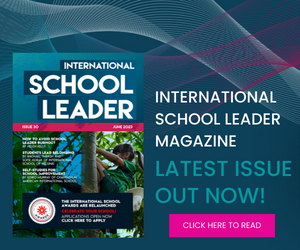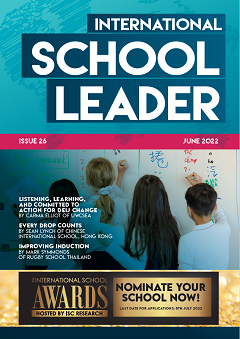Newton College in Alicante, Spain was shortlisted for a 2023 International School Award. Its Principal, Alan Taylor, explains the strategic leadership initiative that was recognised for an award.
By Alan Taylor
Leading a large international school through a pandemic and into the future is teaching me that the right kind of struggle is not only healthy but an essential part of learning and of getting better.
Embracing this idea is helping us to have more focused conversations about our performance, and prepare our students and school to thrive during increasingly uncertain times.
We want to share our learning as we have transformed our self-evaluation practices to focus away from observations of teaching and onto investigations of learning as a good struggle. This article explores five key questions and offers some tips to place learning and a good struggle at the heart of your school community.
Our focus is on learners and their learning which means moving away from observing teachers and teaching.
Why is learning like a good struggle?
We began by asking our learners (as students or adults), ‘What does struggle mean to you?’. We also explored what we mean by a ‘good struggle’ and how this was a useful way to describe learning.
We concluded that a good struggle means learning something new or consolidating ideas in new ways. When learning didn’t happen, this was either because ideas were already well understood and so learners would ‘tread water’ or learning was too difficult and learners would ‘sink’. These four states of learning helped us to define a good struggle as being either learning something new or consolidating ideas in new contexts. A bad struggle (sinking) or no struggle (treading water) were also described clearly. Our aim was then to look for behaviours that indicate in which state of learning a learner was likely to be in any given moment.
Tip: It was essential that our project included all learners from the age of one year up to 18 years. All staff were involved in the research phase of the project and we worked in ‘cross-phase’ groups, with staff from the infants section working alongside secondary staff.
What does a good struggle look like?
Teachers researched what behaviours students would engage in during each of the states of learning. For example, we often show uncertainty when learning something new, and could go on to help others when consolidating a concept. Learners who are treading water or sinking may be distracted or focus on presentational issues, and so are busy but not busy learning. We drew up some illustrative examples of behaviours likely to indicate which one of the four states of learning a learner was in.
We also built up a bank of questions that we could use in order to investigate, by engaging in discussion with learners, what learning was taking place for them. These included:
- How much of a good struggle is this activity?
- How much of a challenge is this (ranking out of a 1–10 score)?
- What can you do now that you couldn’t do this morning?
- What are you getting better at here?
- What is difficult about this?
Tip: We need to be really clear that our focus is on learners and their learning which means moving away from observing teachers and teaching. All of our focus during learning visits is on the behaviours and ideas of the learners and this can take some effort to retrain ourselves during the initial visit phase.
How can we all get involved in looking for learning?
Using our example behaviours and some questions, we spent time visiting lessons to try to identify which of the four states of learning students were in during our visit.
It was important that all teaching staff took a role in evaluating good struggle. All teaching staff and leaders completed learning visits and we completed over 650 in the first year alone. We found that as we completed more visits, the accuracy of our findings improved and any feelings of discomfort lessened. We introduced a ‘not right now’ card which any teacher could show if a visit was not right at that time (for example, if assessments were taking place or if this would be a bad time for any other reason). Learning visits became part of our daily practice.
Tip: Time is precious! We shortened scheduled meetings to offer teaching staff time in lieu of additional time needed to complete learning visits and subsequent discussions. We introduced learning visits of around 20 minutes as a good balance between getting good evidence without excessive time commitments. All conversations were based on the understanding that the visit represented a snapshot of the lesson.
How can we learn from the evidence we collect?
We developed language around our aim for a ‘high-impact lesson’ where good struggle happened for the vast majority of students. This helped us to measure where and when learning was likely to happen, and track changes as a result of action. As a result, individual teachers understand the impact they have on learning and are able to set and meet targets based on the data. Leaders across the school also use the data termly to plan and evaluate actions.
Pre-visit and post-visit conversations helped the visitor and leading teacher have an evidenced-based discussion about where learning was happening in the class and where we could extend the good struggle.
We shared our findings in post-visit conversations and through focused training using feedback from our visits. In assemblies and tutorial times, students developed their ideas about good struggle and we shared our work through parent events and regular newsletters.
Tip: Setting up systems to ensure that data was sensitively and meaningfully shared and used was a critical step. Work out who needs what information and try to set up a termly calendar for sharing and using the information you collect.
How will our focus on learning help wider school improvement?
Our renewed focus on learning and getting better within the classroom is having some surprising benefits across the school. For example:
- Our school improvement planning is now focused upon the impact our work will have on learning and good struggle for our community. So decisions around infrastructure and finance are looked at through the lens of what will have the biggest impact on learning.
- Families understand the impact when we make it clear through social media messaging about getting better and the need for a good struggle. This year, we have begun training some family members on learning visits so they can better understand our work.
- School learning targets and training objectives are now driven by our evaluation of high-impact lessons and factors they have in common. We are also getting better at triangulating evidence within the classroom with other sources to plan action.

Alan Taylor is the Principal at Newton College, in Alicante, Spain which is a member of the International Schools Partnership group (ISP) which has supported this work as part of the group’s innovative approach to learning evaluation. Connect directly with Alan on LinkedIn




